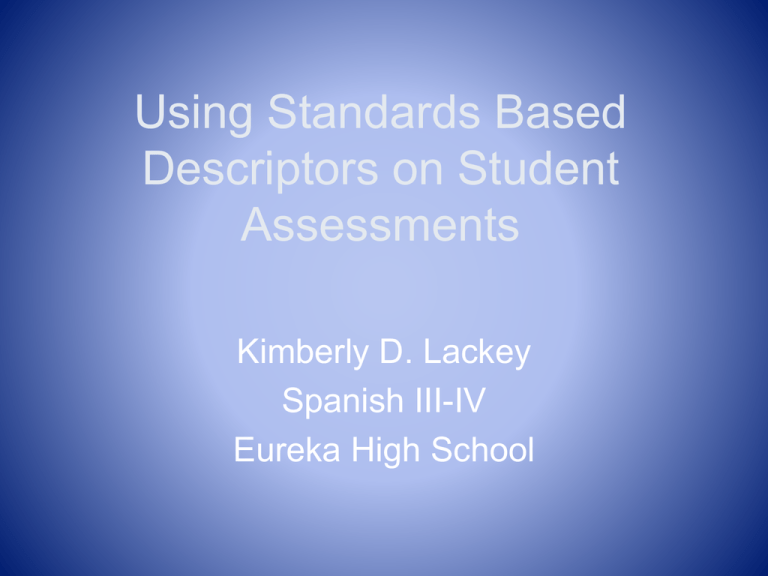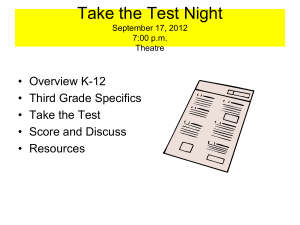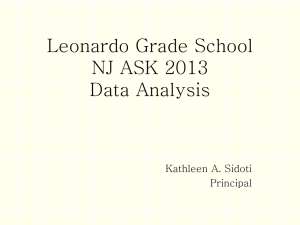Using Standards Based Descriptors on Student Assessments
advertisement

Using Standards Based Descriptors on Student Assessments Kimberly D. Lackey Spanish III-IV Eureka High School Do students react to the results of an assessment differently if they are given a descriptor (below basic, basic, proficient, advanced) instead of a letter grade? • Letter grades are starting to seem outdated • 90% • Need for students in advanced classes to have something to strive towards Context • • • • Classes / Students PLC / Teachers WL Department / Administrators District Grading Scale / Infinite Campus Research • A Repair Kit for Grading: 15 Fixes for Broken Grades by Ken O’Connor • http://www.oconnorgrading.com/index.php - Ask the Grade Doctor • How to Grade for Learning K-12 by Ken O’Connor • Rockwood Spanish Curriculum • Performance Assessment for Language Students rubrics (PALs) from Fairfax County, VA Possible Titles for Performance Standard Levels Advanced Advanced Above Standard Exceptional Consistently Proficient Proficient At Standard Proficient Usually Partial Minimal Approaching Approaching Progressing Below Well Below Beginning How to Grade for Learning, Ken O’Connor, 2002, page 72 Sometimes Seldom EHS WL Department Titles for Performance Standard Levels • Same as MAP test • Each gives a description of the student’s performance / ability related to the standard Advanced Proficient Basic Below Basic Link to Percentages Traditional School Approach Standards-Based Approach 90-100% Outstanding / Excellent 95-100% 80-89% Above Average / 85-94% Good Proficient 70-79% Average / Satisfactory Basic 60-69% Below Average / 74% or below Poor Below Basic 59% or below Failing / Unacceptable Far Below Basic? 75-84% Advanced A year-long process 1) Quizzes (September) 2) Performance Assessments (late September) 3) Listening and Reading Assessments scoring guide (November) 4) Grammar Assessment scoring guide (January) 5) Vocabulary Assessment scoring guide (March) 1) Using the terms (in addition to percentages, instead of letter grades) on quizzes. Buy in from PLCs, discussed with department. 2) Reformatting Scoring Guides for performance assessments Español IV, Capítulo 7 (En el restaurante) GCA: Hablar, Simulated Conversation Interpersonal Speaking Language Control Vocab. Fluency Comprehensibility Task completion 5 50 6 7 53.3 57.7 Below Basic Does not complete the task. Responds inappropriately to most parts/prompts of the conversation. 8 60 9 63.3 10 11 12 67.7 70 73.3 Basic Partially addresses and/or completes the task. Responds inappropriately to some parts/prompts of the conversation. Speech halting and uneven with long pauses or incomplete thoughts. Speech choppy and/or slow with frequent pauses; few or no incomplete thoughts. 13 76.6 14 80 15 16 17 83.3 86.7 90 Proficient Appropriately addresses and completes the task. Responds appropriately and fully to all or almost all parts/prompts of the conversation. 19 20 96.7 100 Advanced Fully addresses and completes the task. Responds fully and appropriately to all or almost all parts/prompts of the conversation. Adds details and elaborates on ideas. 1 2 3 4 Message barely comprehensible, Message mostly comprehensible, Message comprehensible, Message readily comprehensible, requiring frequent interpretation; requiring interpretation; requiring minimal interpretation; requiring no interpretation; pronunciation may frequently pronunciation may occasionally pronunciation does not interfere pronunciation enhances interfere with communication. 1 interfere with communication. 2 with communication. 3 communication. 4 Somewhat fluent speech with some hesitation but speaker manages to continue and complete 1 2 thoughts. 3 Inadequate and/or inaccurate use Somewhat inadequate and/or Adequate and accurate use of of vocabulary. inaccurate use of vocabulary; too vocabulary for level IV. basic for level IV. 1 2 3 Emerging use of basic language Emerging control of basic language Control of basic language structures. (Used correctly about structures. (Used correctly about ¾ structures. (Used correctly most of ½ of the time) of the time). the time, not all of the time). 1 2 3 18 93.3 Fluent and natural speech with few pauses or false starts. 4 Rich use of vocabulary and appropriate use of idiomatic expressions. 4 Excellent control of basic structures withpossible use of advanced language structures. 4 Comentario: _____________________________________________________________________________________________________________________ ________________________________________________________________________________________________________________________________ ________________________________________________________________________________________________________________________________ Español IV, Capítulo 7 (En el restaurante) GCA: Hablar, Simulated Conversation Interpersonal Speaking Language Control Vocab. Fluency Comprehensibility Task completion 5 50 6 7 53.3 57.7 Below Basic Does not complete the task. Responds inappropriately to most parts/prompts of the conversation. 8 60 9 63.3 10 11 12 67.7 70 73.3 Basic Partially addresses and/or completes the task. Responds inappropriately to some parts/prompts of the conversation. Speech halting and uneven with long pauses or incomplete thoughts. Speech choppy and/or slow with frequent pauses; few or no incomplete thoughts. 13 76.6 14 80 15 16 17 83.3 86.7 90 Proficient Appropriately addresses and completes the task. Responds appropriately and fully to all or almost all parts/prompts of the conversation. 19 20 96.7 100 Advanced Fully addresses and completes the task. Responds fully and appropriately to all or almost all parts/prompts of the conversation. Adds details and elaborates on ideas. 1 2 3 4 Message barely comprehensible, Message mostly comprehensible, Message comprehensible, Message readily comprehensible, requiring frequent interpretation; requiring interpretation; requiring minimal interpretation; requiring no interpretation; pronunciation may frequently pronunciation may occasionally pronunciation does not interfere pronunciation enhances interfere with communication. 1 interfere with communication. 2 with communication. 3 communication. 4 Somewhat fluent speech with some hesitation but speaker manages to continue and complete 1 2 thoughts. 3 Inadequate and/or inaccurate use Somewhat inadequate and/or Adequate and accurate use of of vocabulary. inaccurate use of vocabulary; too vocabulary for level IV. basic for level IV. 1 2 3 Emerging use of basic language Emerging control of basic language Control of basic language structures. (Used correctly about structures. (Used correctly about ¾ structures. (Used correctly most of ½ of the time) of the time). the time, not all of the time). 1 2 3 18 93.3 Fluent and natural speech with few pauses or false starts. 4 Rich use of vocabulary and appropriate use of idiomatic expressions. 4 Excellent control of basic structures withpossible use of advanced language structures. 4 Comentario: _____________________________________________________________________________________________________________________ ________________________________________________________________________________________________________________________________ ________________________________________________________________________________________________________________________________ 3) Expanding the scoring guide format for use with listening and reading assessments Hora ______ Nombre ______________________________________________________________ #_______ Español IV, Capítulo 8 La convivencia y la aculturación GCA: Leer Main Idea Analysis / Meaning Supporting Details summary from context 50% 3 54.6% 59.1% 4 5 Below Basic Unable to accurately identify details from the reading selections. (6 or fewer correct) 1 63.6% 6 68.2% 7 Basic 72.7% 8 Accurately identifies minor details from portions of the reading selections. (7-8 correct) 2 77.3% 9 81.8% 86.4% 10 11 Proficient Accurately identifies minor details from the majority of the reading selections. (9-10 correct) 3 90.1% 12 95.5% 100% 13 14 Advanced Accurately identifies minor details from the all or almost all of reading selections. (11-12 correct) 4 Identifies accurate meaning for one or fewer words based on context of selection. Identifies accurate meaning for some words (2-3) based on context of selection. 1 Attempts to define terms Defines terms presented in presented in article, but errors article with some errors in in comprehension impede comprehension. communication. 1 Unable to demonstrate accurate interpretation of the main ideas of the reading selection. 0 Identifies accurate meaning for most words (4-5) based on context of selection. 2 3 Defines terms presented in article with few errors in comprehension. 2 Identifies accurate meaning for all words based on context of selection. 4 Accurately defines terms presented in article with detail, precision, and clarity. 3 4 Demonstrates accurate interpretation of main idea of the reading selection. 2 4) Expanding the scoring guide format to grammar assessments Español 3—Capítulo 3-2 Gramática—los mandatos formales y plurales 5 50 Choice of Affirmative vs. Negative Command (Vocabulary) Choice of Register (Ud. or Uds. Command) Formation of Commands (Verb forms) Use of pronouns Accent marks 6 53.6 7 57.2 8 60.7 9 64.3 10 67.9 11 71.4 12 75 Below Basic Basic Significant errors in comprehension of vocabulary when choosing to make commands affirmative or negative. (5 or more errors) 1 Significant errors in understanding of whom to address with Ud. vs.Uds. (5 or more errors) 1 Significant errors in command forms. (5 or more errors) 1 Significant errors in correct choice and placement of reflexive pronouns with affirmative and negative commands. (3 or more errors) 1 4 or more errors in inclusion of and/or placement of accent marks. 1 Some errors in comprehension of vocabulary when choosing to make commands affirmative or negative. (3-4 errors) 13 78.6 14 82.2 15 85.7 16 89.3 17 92.9 Proficient 2 3 Usually demonstrates understanding of whom to address with Ud. vs.Uds. (1-2 errors) 2 3 Some errors in command forms. (3-4 errors) Most commands forms are grammatically correct. (1-2 errors) 2 Some errors in correct choice and placement of reflexive and direct object pronouns with commands. (2 errors) Usually demonstrates correct choice and placement of reflexive pronouns with affirmative and negative commands. (1 error) 2 2-3 errors in inclusion of and/or placement of accent marks. 2 19 100 Advanced Usually demonstrates comprehension of vocabulary when choosing to make commands affirmative or negative. (1-2 errors) Some errors in understanding of whom to address with Ud. vs.Uds. (3-4 errors) 18 96.4 3 Demonstrates advanced comprehension of vocabulary when choosing to make commands affirmative or negative. (0 errors) 4 Demonstrates advanced understanding of whom to address with Ud. vs.Uds. (0 errors) 4 Commands are grammatically correct. (0 errors) 4 Demonstrates correct choice and placement of reflexive pronouns with affirmative and negative commands. (0 errors) 3 Uses accent marks only when necessary and places them correctly on commands. (0-1 errors) 4 3 5) Expanding scoring guide format to vocabulary quizzes Percentage Raw Score Unit Vocabulary – Spelling (including diacritical marks) Unit Vocabulary Application – Meaning & Grammar (conjugations, agreement, word order) Overall Language Use – Grammar & Vocabulary Overall Communication – Content Overall Communication – Comprehensibility 50 52 54 46 48 60 62 64 66 68 70 72 74 76 78 80 82 84 86 88 90 92 94 96 98 100 7 8 9 10 11 12 13 14 15 16 17 18 19 20 21 22 23 24 25 26 27 28 29 30 31 32 Below Basic 1 targeted word spelled correctly Basic 3 targeted words spelled correctly Proficient 4 targeted words spelled correctly Advanced 2 targeted words 5 or more targeted words spelled correctly spelled correctly, including all or almost all diacritical 2 4 6 8 marks 10 1 targeted word applied 2 targeted words 3 targeted words 4 targeted words applied 5 or more targeted words correctly in context with applied correctly in applied correctly in correctly in context with applied correctly in context correct grammatical structures context with correct context with correct correct grammatical with correct grammatical grammatical grammatical structures structures 2 structures structures 6 8 10 4 Significant errors in basic Errors in basic grammatical Few errors in grammatical No or only minor errors in grammatical structures and/or structures and/or vocabulary, structures and/or vocabulary grammatical structures vocabulary, (including spelling) (including spelling) somewhat (including spelling) do not and/or vocabulary inhibit communication. 1 inhibit communication. 2 inhibit communication. 3 (including spelling). 4 Inadequate, inaccurate, and/or Some information in responses Appropriate response to Substantial response to irrelevant response. may be incorrect or irrelevant. prompt that provides correct prompt that provides Limited response and relevant correct and relevant information with 1 2 3 elaboration. 4 Large portions of responses are very Responses are understood with Responses are understood with Responses are easily difficult to understand and must be some interpretation by the reader. minimal interpretation by the understood. Reader does interpreted by the reader. reader. not have to “interpret” 1 2 3 meaning. 4 6) Sharing our work • • • • Spanish I, II, and AP PLCs French, German, Latin, ASL PLCs EHS SBGR Book Study Group WL Departments at Lafayette, Rockwood Summit, and Marquette • Foreign Language Association of Missouri Fall Conference, 2011 • Central States Conference on the Teaching of Foreign Languages, March 2012 Data Collection Sources 1. Student surveys (through Survey Monkey) 2. Teacher surveys 3. Comparison of student grades from Chapter 3-3 reading GCA from 2010 and 2011 (points vs scoring guide) Student surveys (through Survey Monkey) • 178 Students • Spanish III and Spanish IV • Students from 3 different teachers, 2 different PLCs • All have had level II or III with traditional grading and level III or IV with Standards Based Grading Student Comments • • • • • • Pro-Standards Based Pro-Traditional Grading / Percentages Pro-Hybrid of SBG and Letter Grades Indifference Huh? Changes that should be made Teacher surveys • 3 Teachers • 2 PLCs • Each teacher has had extensive experience in using traditional letter grades and percentages and has followed the same pattern of using SBG descriptors and scoring guides during this school year 1. What do you perceive as the impact of using the terms Advanced / Proficient / Basic / Below Basic on student assessments? • Students are more motivated to get above just 90%, students understand at what level (basic, below basic) they should be retaking - as opposed to just retaking to get a higher percentage. • Students are given a better understanding of their strengths and weaknesses - what they know well and what they still need to learn. • Students have clearer understanding of their grades and learning. Comparison of student grades from Chapter 3-3 reading GCA from 2010 and 2011 (points vs scoring guide) • Same task • 2010 – 2 points main idea, 1 point each supporting detail, 1 point each vocab in context (16 points) • 2011 – Based on scoring guide, standards based (10 points raw score) Main Idea Realidades 3: GCA – Leer Capítulo 3-3 FORMA A 50% 56.3% 62.5% 68.8% 2 3 4 5 Below Basic Basic Unable to demonstrate accurate interpretation of the main ideas of the reading selection. 0 75% 6 81.3% 87.5% 93.8% 100% 7 8 9 10 Proficient Advanced Demonstrates accurate interpretation of main idea of the reading selection. Supporting Details 2 Unable to accurately identify details from the reading selections. (5 or fewer correct) 1 Accurately identifies minor details from portions of the reading selections. (67 correct) 2 Accurately identifies minor details from the majority of the reading selections. (8 correct) 3 Accurately identifies minor details from the all or almost all of reading selections. (910 correct) Meaning from context 4 Identifies accurate meaning for one or fewer words based on context of selection. 1 Identifies accurate meaning for some words (2-3) based on context of selection. Identifies accurate meaning for most words (4-5) based on context of selection. 2 Identifies accurate meaning for all words based on context of selection. 3 4 Traditional vs Standards Based Grading 2010 Reading GCA • 86.9% Average • 24/48 (50%) Advanced • 17/48 (35%) Proficient • 5/48 (10%) Basic • 2/48 (4%) Below Basic • 24/48 (50%) A • 12/48 (25%) B • 5/48 (10%) C • 5/48 (10%) D • 2/48 (4%) F 2011 Reading GCA • 94.3%Average • 30/42 (90.5%) Advanced • 12/42 (29%) Proficient • 0 Basic • 0 Below Basic • 30/42 (90.5%) A • 12/42 (29%) B • 0C • 0D • 0F Possible Conclusions • The Standards Based scale is more generous; students can make one mistake and still get a 100%, 3 mistakes is -12% instead of -18%. • The feedback on previous reading assessments from the SB scoring guide helped students to improve on their areas of weakness over the year. • This year’s students are more academically gifted. Amount of points deducted 2010 Traditional Grading • -1 = 94% • -2 = 88% • -3 = 81% • -4 = 75% • -5 = 69% • -6 = 63% • -7 = 56% • -8 = 50% • -9 = 44% 2011 Standards Based Rubric • -1 = 94-100% • -2 = 88-94% • -3 = 91-94% • -4 = 75-88% • -5 = 75%-81.3% • -6 = 75% • -7 = 69% • -8 = 63% • -9 = 56% Conclusions • I learned that… – You can make Standards Based Grading Work, even if it’s not totally compatible with Infinite Campus – Students have strong ties to traditional grading practices – I can be much more precise in my feedback about student performance by using standards rather than numbers / letters What’s next? • Consider adding a “Far Below Basic” level • Continue to monitor and adjust scoring guides • Educate parents at Open House and Parent/Teacher Conferences, consider how to get grade communications into parents’ hands New Questions • Are other departments attempting something similar? What descriptors are they using? • Do other teachers / administrators agree with the mathematics used? 50% lowest grade? 83.3% = Proficient? • How will our role at the high school change as students graded by standards in elementary school get older? • What issues do teachers outside of my PLC have with the descriptors / the new scoring guides? • In the end, are students achieving at a higher level than before? Have they broken out of the 90%?






